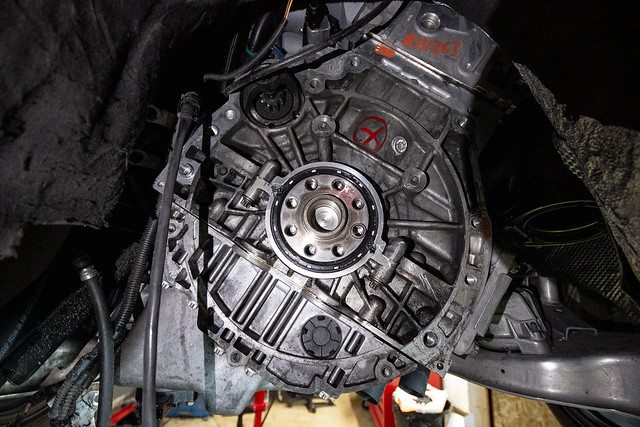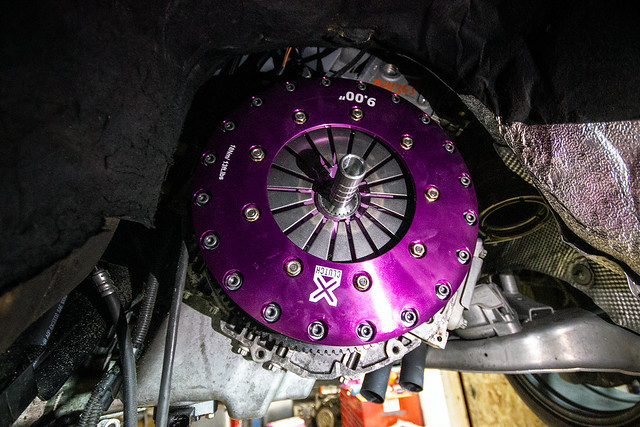XClutch N54 Twin Disc Review & Installation – BMW 135i & 335i (6MT)
After my Spec Stage 3+ clutch started to slip after only 5,000 miles at 691 wtq (at the wheels), I was forced to search for another new clutch. The Spec clutch was only rated at 671tq (at the crank), I thought it would be capable of holding more power. My search of 1000+ tq rated clutches led me to twin disc options for the N54.
As some of you might be aware, there is a new twin disc clutch option for those of us with manual N54’s. Xtreme Performance Clutch (or XClutch) is an Australian company that specializes in clutches for performance vehicles overseas. MFactory is an authorized distributor of their products in the US. This allows for faster shipping and domestic support.
XClutch has many different clutches for our platform, but I narrowed my options down to their 9″ ceramic twin disc and their 9″ organic twin disc. The only differences between the two are the clutch material, torque capacity and driving experience. The ceramic version is slightly harder to drive, but the torque rating is much higher. The organic version is easier to drive, but it’s torque rating is lower. Basically, it was a street vs. race decision.
XClutch Twin Disc Options
- 9″ (230mm) Rigid Ceramic (1232 ft/lb rating)
- 8 bolt (up to 12/2008) – KBM23595-2E
- 6 bolt (from 01/2009) – KBM23594-2E
- 9″ (230mm) Rigid Organic (892 ft/lb rating)
- 8 bolt (up to 12/2008) – KBM23595-2G
- 6 bolt (from 01/2009) – KBM23594-2G
For more information, check out the complete XClutch catalog. Otherwise you can view the 135i brochure or the 335i brochure.
I ordered the ceramic version of the clutch, which is capable of holding more torque and is meant for track-driven cars. I received the clutch a few days after ordering and was very impressed with the quality!
It comes with the following:
- Flywheel bolts
- Pilot bearing
- Throwout bearing (metal)
- Alignment tool (metal)
- Locktite
- Flywheel & clutch assemblies

I couldn’t wait to get it installed! While you’re in there, I’d highly recommend replacing a few other parts that have to be replaced/removed anyways.
Here is the list of items I replaced at the same time:
- Transmission Bellhousing Bolts (one-time use)
- Downpipe Gaskets (2)
- Rear Main Seal
- Upgraded Clutch Delay Valve
- Royal Purple Transmission Fluid (2 qts)
- Upgraded Brass Clutch Fork Pivot Pin
- Poly Transmission Mounts
- Clutch Pedal Stop



Break-in Overview
The recommended break-in mileage is 1000 kilometers (621 miles). This should include mostly city driving where you are frequently using the clutch. Racking up highway miles aren’t going to help break in the clutch. I noticed that the driveability gets better and all noises quiet down a little after 500 miles. It will never be as quiet or as smooth as a stock clutch… but it’s much more capable than the stock clutch.
Noise Overview
The clutch does have a metallic whirring noise when the pedal is depressed. This does not bother me, but it might bother some of you who don’t like noise. Please watch my video at the bottom of this post to hear the noise.
As with any single mass flywheel or twin disc, you will have low RPM gearbox chatter. While idling and while driving at high load/low RPM, you can hear it. If this bothers you, you will have to stick with an OEM-style dual-mass flywheel clutch setup. Otherwise, you can raise the idle via MHD to 900 RPMs or so to reduce the chattering.
However, at power levels of 600whp+, the stock DMFW is not recommended and there are not a lot of upgraded clutch options available that mate up to the stock DMFW. I’ve used many different clutch/flywheel setups in these N54s, and have no qualms with the increased noise of a SMFW or twin disc. It’s all part of the game when you’re chasing horsepower!
Driveability Overview
I knew the ceramic version of the clutch would be a little more difficult to drive than the organic version, so please take that into consideration when reading my review or purchasing the clutch.
The pedal is stiffer/heavier than stock, but not by much. It’s effortless to depress, which is good. Engagement doesn’t happen until the top of the pedal during release. My stock clutch and my Spec Stage 3+ clutch both engaged a lot closer to the floor, so this took some getting used to. Installing the clutch stop helped, but still has an area of dead space in the pedal. Again, watch my video at the bottom of this post to see how much dead space there is.
Once the engagement starts, the window is fairly small. You don’t have a lot of slipping area, and this can result in a shuttering take-off until you learn the clutch. I’ve heard that the organic version is a little more forgiving in this sense. After breaking the clutch in, it gets better.
The clutch itself is very grabby, just like it should be. I was getting slippage between gears in my old Spec Stage 3+ and this one grabs right away, which is great. I have no concerns about it holding any power I’m capable of making right now (752whp/691wtq+).
Check out the video I put together of the clutch. It includes an install timelaspe, some driving, and my impressions of the noise/pedal engagement. If you’re into BMWs or N54 stuff, give me a thumbs up on YouTube and subscribe to my channel!
Overall, it takes some getting used to but once you learn the clutch, it’s definitely streetable. I drive my car frequently in the summer and am happy to have a clutch that will hold the power. If you don’t have high power goals, I would recommend the organic version of this clutch. If you plan on making 700wtq+ or more, I would definitely go with the ceramic version.
I hope this post is helpful to those who are considering this clutch, or other high horsepower clutch setups. Please leave a comment below and I’ll do my best to answer them from an enthusiast point of view.
2019 Update:
I ran a 10 second 1/4 mile pass with this clutch. It’s holding up great, takes the abuse and really grabs!
This page contains affiliate links. If you purchase anything using the links above, I will earn a small commission at no extra cost to you. Win-win!